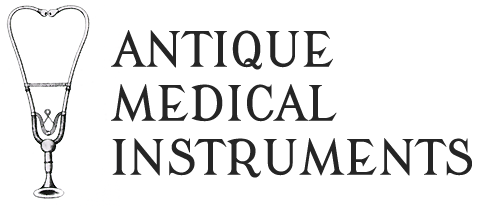NATAN SCHLEIDER GALLERY, L.L.C. IS PLEASED TO OFFER FREE CONSULTATION AND COMMUNICATIONS IF YOU OWN ANY MEDICAL ANTIQUES OR COLLECTIONS WHICH YOU ARE CONSIDERING BUYING OR SELLING OR TRADING.
BUYING
Many items on this site are not for sale. They are part of the personal collection of Dr. Natan Schleider. If an item is of particular interest, please contact us. We may have duplicates or know a fellow collector or dealer who can track one down.
SELLING
If you have a medical antique item or collection that you would like to sell or get appraised, feel free to contact the Natan Schleider Gallery, L.L.C. Since 2011, we have made all the mistakes beginners make when buying and selling medical and surgical antiques and have learned from them. At first, having no guidance, we learned the following:
- In general, only items from the 1880s or earlier are desirable or collected. This is only a generalization, we do know collectors who have great items from the late 19th century and 20th century!
- Items that are not in excellent condition tend to be far less valuable—better to have one mint item that costs $1,000 than 10 similar chipped identical items that cost $100.
- Many dealers we bought items from seriously over-charged.
- Items bought at auction were not well photographed or described.
- Items sold at auction ended up selling well below market value and the auction house took a big cut for itself, leaving the seller with little to no profit—many were lucky to break even after a lifetime of collecting.
- We started keeping meticulous regards of items we had purchased via images, spreadsheets, and item numbers.
- We formed a circle of experts on all different types of antiques since nobody can know it all.
- We got rid of the “junk” and low value items by charitable donation, knowing that if we wanted the best high-end buyers, we needed to present high-end collectibles (and at least pretended at first like we knew what we were doing).
We recommend doing your homework to ascertain fair market value for your items. This can be done relatively easily by checking recent sales at auction houses or by going to ebay.com and clicking on “Sold Listings” for items you are selling. So you have decided to sell you collection. What are your options?
- You can approach a dealer. They will buy quality items but in general, will pay 50 percent of its value since they need to make a profit.
- You can use an auction house. Most auction houses do not specialize in medical and surgical antiques. Moreover, if you have a large collection, they will bundle several items into “lots” which often are overlooked and sell for bottom dollar. We know this after attending the Eli Buck Auction and the Dr. Burke auction.
- You can sell on ebay.com on your own. If you know what you are doing, are patient, know how to take good pictures and describe your item, this could be effective although time consuming and hit or miss—you never know who is searching on ebay.com?
- You can donate to a museum or charitable organization. To do this, you need a formal appraisal (which you need to pay for) and IRS Tax Form 8283 completed. This can be laborious but at least it goes to a good cause and gets you a deduction on your taxes.
- You can reach out to us and other fellow collectors listed on this site. This can be highly satisfying since you know your items are going to a good home and can get second and third opinions free of charge for what your collection is worth. Natan Schleider Gallery, L.L.C., seeks to preserve medical antiquities, not profit from them.
TRADING
We love to trade. Since I was a kid, I traded baseball cards with my friends. If you have good stuff you are interested in trading, please reach out to us. Antiques most sought after include the following from before 1880s: antiquarian medical books in very good to excellent condition; civil war medical items and books for the civil war period; anything marked “USA HOSPITAL DEPT” or “USA MEDICAL DEPARTMENT”; antique diagnostic instruments like stethoscopes and pleximeters; antique microscopes; any surgical antiques that are in cases and/or related to surgical specialties like ophthalmology; obstetrics and gynecology; ear, nose and throat; CDVs,; leech jars; scarificators; medical ephemera like medical maps, medical lecture cards, civil war swords, apothecary jars and chests, the list goes on! The older the item and the better the condition, the more likely it is to have value; however, just because it is old does not make it valuable (think about a completely rusted 1965 Ford Mustang that has been sitting outside for 50 years).

